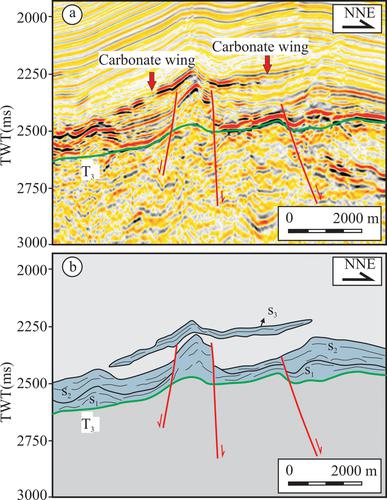当前位置:
X-MOL 学术
›
Acta Geol. Sinica Engl. Ed.
›
论文详情
Our official English website, www.x-mol.net, welcomes your
feedback! (Note: you will need to create a separate account there.)
Seismic Characteristics and Development Patterns of Miocene Carbonate Platform in the Beikang Basin, Southern South China Sea
Acta Geologica Sinica-English Edition ( IF 3.5 ) Pub Date : 2020-01-25 , DOI: 10.1111/1755-6724.14399 Wei YAN 1, 2, 3 , Guangxue ZHANG 1, 2 , Bin XIA 1 , Li ZHANG 2, 3 , Zhen YANG 2, 3 , Zhenyu LEI 2, 3
Acta Geologica Sinica-English Edition ( IF 3.5 ) Pub Date : 2020-01-25 , DOI: 10.1111/1755-6724.14399 Wei YAN 1, 2, 3 , Guangxue ZHANG 1, 2 , Bin XIA 1 , Li ZHANG 2, 3 , Zhen YANG 2, 3 , Zhenyu LEI 2, 3
Affiliation

|
The Beikang Basin is located in the southern part of the South China Sea (SCS), which is one of most tectonically complex sea areas. It is a deepwater sedimentary basin that was mainly deposited during the Cenozoic era. Owing to data restrictions, the research on carbonate platforms of this area is still in its infancy. High‐resolution seismic data are analyzed to identify the Miocene carbonate platforms and reconstruct the architecture and growth history. The carbonate platforms of Beikang Basin began to develop in the Late Oligocene‐Early Miocene, were extended in the Middle Miocene, and declined in the Late Miocene. The carbonate platform mainly developed during two periods: the Oligocene to the Early Miocene, and the Middle Miocene. The carbonate platforms that developed in the Middle Miocene were the most prosperous. The Middle Miocene carbonate platform in the Beikang Basin can be divided into three stages. In the first stage, the platforms had wide range which were thin. During the second stage, the platforms had a smaller range that was controlled by faults. In the third stage, the platforms were gradually submerged. The platform structure developed in the Middle Miocene at the Beikang Basin was controlled by the rate of rising/falling of the sea level and the carbonate growth rate. Based on an analysis of these changes and relationship, the platform can be divided into several patterns: retrogradation, submerged, aggradation, progradation, outward with up‐stepping, outward with down‐stepping, and down‐stepping platforms. At the top of the carbonate platforms in the Beikang Basin a set of carbonate wings or mushrooms usually appeared. These were formed during a period of relative sea‐level decline. It is believed that the Miocene carbonate platforms in the Beikang Basin are mainly controlled by tectonic and sedimentary environments, and are also affected by terrestrial detritus.
中文翻译:

南海南部北康盆地中新世碳酸盐岩台地的地震特征和发育模式
北康盆地位于南海(SCS)的南部,南海是构造最复杂的海域之一。它是一个深水沉积盆地,主要沉积在新生代时期。由于数据的限制,该地区碳酸盐岩台地的研究仍处于起步阶段。分析高分辨率地震数据以识别中新世碳酸盐岩台地并重建构造和生长历史。北康盆地的碳酸盐岩台地在渐新世晚期至早中新世开始发育,在中新世中期扩展,而在中新世后逐渐下降。碳酸盐台地主要在两个时期发育:中新世至中新世。中新世中期发育的碳酸盐岩地台最为繁荣。北康盆地中中新世碳酸盐岩台地可分为三个阶段。在第一阶段,平台范围很广,很薄。在第二阶段,平台的故障范围较小。在第三阶段,平台逐渐被淹没。北康盆地中新世中期发育的台地结构受海平面上升/下降速度和碳酸盐增长率的控制。基于对这些变化和关系的分析,该平台可以分为几种模式:回溯,淹没,凝结,升级,向外加升,向下加降和降级。在北康盆地碳酸盐岩平台的顶部,通常会出现一组碳酸盐岩的翼或蘑菇。这些是在相对海平面下降时期形成的。人们认为,北康盆地中新世的碳酸盐岩台地主要受构造和沉积环境的控制,也受到陆地碎屑的影响。
更新日期:2020-01-25
中文翻译:

南海南部北康盆地中新世碳酸盐岩台地的地震特征和发育模式
北康盆地位于南海(SCS)的南部,南海是构造最复杂的海域之一。它是一个深水沉积盆地,主要沉积在新生代时期。由于数据的限制,该地区碳酸盐岩台地的研究仍处于起步阶段。分析高分辨率地震数据以识别中新世碳酸盐岩台地并重建构造和生长历史。北康盆地的碳酸盐岩台地在渐新世晚期至早中新世开始发育,在中新世中期扩展,而在中新世后逐渐下降。碳酸盐台地主要在两个时期发育:中新世至中新世。中新世中期发育的碳酸盐岩地台最为繁荣。北康盆地中中新世碳酸盐岩台地可分为三个阶段。在第一阶段,平台范围很广,很薄。在第二阶段,平台的故障范围较小。在第三阶段,平台逐渐被淹没。北康盆地中新世中期发育的台地结构受海平面上升/下降速度和碳酸盐增长率的控制。基于对这些变化和关系的分析,该平台可以分为几种模式:回溯,淹没,凝结,升级,向外加升,向下加降和降级。在北康盆地碳酸盐岩平台的顶部,通常会出现一组碳酸盐岩的翼或蘑菇。这些是在相对海平面下降时期形成的。人们认为,北康盆地中新世的碳酸盐岩台地主要受构造和沉积环境的控制,也受到陆地碎屑的影响。











































 京公网安备 11010802027423号
京公网安备 11010802027423号